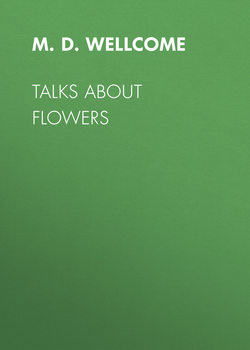Читать книгу Talks About Flowers - M. D. Wellcome - Страница 6
The Phlox Drummondii
Оглавление"Flowers for gladness and flowers for sorrow,
Shadowing forth what we fail to tell;
Mystic symbols of tender meanings,
Such as the heart interprets well."
THIS is one of the most desirable of our annuals, coming into bloom early in the season and continuing in flower till frost. They are very effective in massed colors, and make fine ribbon beds. Contrasting shades should be selected. A writer in the Garden says that the following are very desirable for this purpose: "Phlox Lothair, salmon shaded with violet; Mons Henrique, brilliant reddish crimson; Venus, pure white; Mons Goldenschugh, rosy violet; Spenceri, dark rosy lilac. An excellent front edging for this ribbon bed is the variegated Periwinkle. In order to grow them thoroughly well, and so to insure a lengthened period of blooming, the ground should be deeply trenched and well enriched with good manure from the farm yard, and not more than six heads of bloom should be allowed to each plant. Thus treated, when planted in long lines, it is difficult to convey an impression of these and similar varieties."
There are many beautiful varieties of color; deep blood purple, brilliant scarlet, large blue with white eye, not truly a blue, but the nearest approach to it of any; Leopoldii, splendid deep pink, with white eye; Carmine Queen and Violet with a large white eye; Vick's New Double White, the only one that is reliable, from seed, to produce double flowers. Then there are the buffs and the stripes, crimson striped with white, and rose and purple. Mr. Vick, who makes a specialty of the Drummondii Phlox, they being a favorite with him, devotes acres to their cultivation, and who has been experimenting with them for several years, has produced several new sorts that are very fine; one of them is deep red with a fringed edge. There have been very marked improvements since this plant was first discovered in Texas by Mr. Drummond, a botanical collector sent out by the Glasgow Botanical Society, and it was one of the last, if not the very last, sent to Europe by him. He soon after went to Cuba, where he died of a fever in the prime of life. Sir N. J. Hooker named the plant after its discoverer as a memento. When first discovered it was very inferior to the flowers seen in our gardens, as is very apparent from an engraving of it taken from a drawing in Mr. Vick's possession, which was made in 1838, three years after its discovery. It is given in Vick's Magazine for September, 1880, with the items we have cited. The word Phlox signifies flame, and is supposed to have been applied in allusion to the flame-like form of the bud.
A lady who had excellent success with her seedlings, started early in a box, and bedded out one cloudy day in May, says: "I was surprised to find flowers on the plants when so young and small. I don't believe they had been transplanted five days before half of them had flowers, and soon the rest followed, and for more than two months my bed has been glorious—a mass of bright colors more beautiful than any carpet or dress pattern ever made. It is near the middle of September, and if the frost will only keep away, it looks as though they would keep on flowering for years. Tell everybody to have a Phlox bed and how to do it. It is the cheapest pleasure possible."
CARRIE, in Vick's Magazine.
